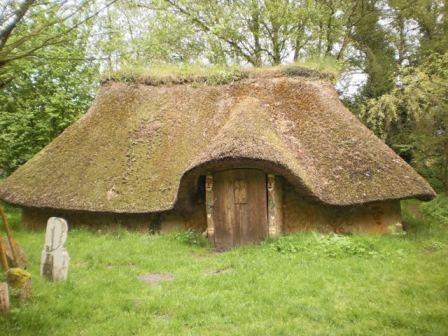Many animals, including insects and fish, find or create a protected place, a cave, in order to withdraw as safe as possible. Especially to sleep.
 Many animals have a safe and warm place where their weak offspring can grow protected. Sometimes the nest or den also features a soft interior lining (mice, moles, rats). Insects make cocoons, honeycomb, or a paper wasp nest, a hole, or a structure such as ants (termite,...).
Many animals have a safe and warm place where their weak offspring can grow protected. Sometimes the nest or den also features a soft interior lining (mice, moles, rats). Insects make cocoons, honeycomb, or a paper wasp nest, a hole, or a structure such as ants (termite,...).
A rabbit makes tunnels, the beaver a house with several rooms.
Genetically closer there are gorillas who daily make a solid nest of branches. Often with a mattress. Sometimes with cover, rarely with a shed.
Masters in housing are feathery. Swallows make masonry with mud, straw and saliva, a sturdy construction. Weavers (Southern masked weaver - Ploceus velatus, Sociable Weaver - Philetairus socius, Baya weaver - Ploceus philippinus) braid with grasses beautiful hanging nests to impress a female. The Bower Bird (Ptilonorhynchidae) therefore even decorates it with groups of colored berries, mushrooms and waste.
With our skills and intelligence, we managed to leave natural caves and build shelters ourselves. Meanwhile insane skyscrapers reach to 1,000 meters.
With the resources that we find in our environment we can construct a shelter.
An igloo of snow,
our own hole in the ground or in a rock,
a sod hut,
a roof of reeds...
Originally built in mud, houses collapsed after a time. The land was flattened, and then rebuilt again. Thus arose a residential hilling: a tel(l) (also (archeological) mound).
Wood and later domes have long been the only way to create large spans. Building materials were endlessly recycled, oak beams for houses, limestone of pyramids and marble from temples.
On leased land (in the 15th and 16th centuries e.g. leased for 44 years) of abbeys and landlords users, starting farmers, were alowwed to erect house and stables, and to carry it again later. The whole house (wood, wicker, reeds, clay) was 100% removable and reusable!
Wood and clay are, as long as you keep them dry under a good roof, excellent building materials. They get right back in recent years more attention in modern architecture.
Folk architecture (or Vernacular Architecture) is based on local needs, materials and traditions. It is practical, functional and environmentally, usually without designer or architect. Structures range from tents and (log) cabins to houses and pagodas.
